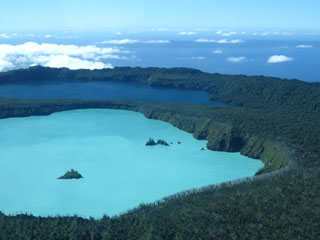Report on Ambae (Vanuatu) — 20 September-26 September 2017
Smithsonian Institution / US Geological Survey
Weekly Volcanic Activity Report, 20 September-26 September 2017
Managing Editor: Sally Sennert.
Please cite this report as:
Global Volcanism Program, 2017. Report on Ambae (Vanuatu) (Sennert, S, ed.). Weekly Volcanic Activity Report, 20 September-26 September 2017. Smithsonian Institution and US Geological Survey.
Ambae
Vanuatu
15.389°S, 167.835°E; summit elev. 1496 m
All times are local (unless otherwise noted)
On 23 September the Vanuatu Geohazards Observatory (VGO) stated that activity at Aoba continued to increase, prompting them to raise the Alert Level to 4 (the second highest level on a scale of 0-5). On 24 September photos showed an ash plume rising above the crater rim, and ashfall was reported in areas across the island. One report noted that ashfall had been reported for a few weeks. The Vanuatu government’s Council of Ministers declared a state of emergency on the island on 26 September; about 36 schools were closed. That same day the New Zealand Defence Force conducted an overflight and posted a video showing an ash plume and lava fountains rising from the vent. On 27 September a news article stated that about 8,000 residents were in 35 evacuation shelters, mostly evacuated from the N and S parts of the island to the E and W areas.
Geological Summary. The island of Ambae, also known as Aoba, is a massive 2,500 km3 basaltic shield that is the most voluminous volcano of the New Hebrides archipelago. A pronounced NE-SW-trending rift zone with numerous scoria cones gives the 16 x 38 km island an elongated form. A broad pyroclastic cone containing three crater lakes (Manaro Ngoru, Voui, and Manaro Lakua) is located at the summit within the youngest of at least two nested calderas, the largest of which is 6 km in diameter. That large central edifice is also called Manaro Voui or Lombenben volcano. Post-caldera explosive eruptions formed the summit craters about 360 years ago. A tuff cone was constructed within Lake Voui (or Vui) about 60 years later. The latest known flank eruption, about 300 years ago, destroyed the population of the Nduindui area near the western coast.
Sources: Vanuatu Meteorology and Geohazards Department (VMGD), Radio New Zealand, Radio New Zealand, Asia Pacific Report, Asia Pacific Report, New Zealand Defence Force (NZDF), Yumi Toktok Stret News

